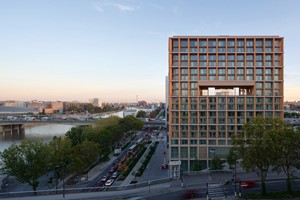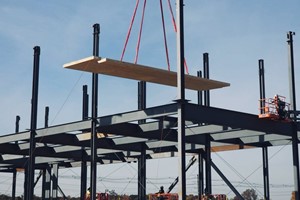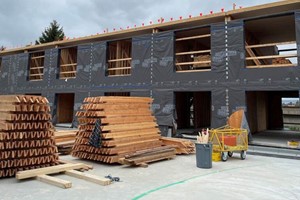In various parts of the world, dozens of 3D-printed homes have been constructed, ranging from housing for families in Virginia to providing shelter for impoverished communities in rural Mexico. The largest 3D-printed neighborhood globally is currently under construction near Austin, Texas. This technology holds significant potential for places like Maine, where a report released last year by three state agencies indicated that approximately 80,000 new homes will be needed by 2030 to address a housing shortage.
Habib Dagher, executive director of the University of Maine’s Advanced Structures and Composites Center (ASCC), believes he has a solution to this pressing issue. In a recent video call with CNN, Dagher discussed the unveiling of the ASCC’s latest innovation: the world’s largest polymer 3D printer. Dubbed the “Factory of the Future 1.0,” Dagher hopes this printer will help alleviate Maine’s housing crisis and revolutionize 3D-home-printing.
“The approach we’ve taken is quite different from what you’ve seen, and you’ve been reading about for years,” Dagher stated.
A Home Every 48 Hours
3D-printing technology has been employed in recent years to construct various structures, including businesses, bridges, and mosques. One non-profit organization is even working on printing schools in conflict zones. Dubai, in the United Arab Emirates, currently holds the Guinness World Record for the largest 3D-printed structure and aims to have 25% of new buildings constructed using 3D printing technology by 2030.
Most 3D printing efforts rely on concrete, using a robotic arm equipped with a nozzle to layer wet concrete into the desired shape. However, ASCC is taking a different approach. Their giant printer, along with its predecessor—certified by Guinness World Records in 2019 as the “largest prototype polymer 3D printer”—is unique in that it constructs homes using wood residuals.
In late 2022, the ASCC introduced the “BioHome3D,” a 600-square-foot single-family unit that is the world’s first 100% bio-based 3D-printed home. This structure was built using local wood fiber and bio-resin materials.
“When they’re doing concrete, they’re only printing the walls,” Dagher explained. He noted that the floor, roof, and walls of the BioHome3D were all printed. Additionally, concrete homes need to be constructed on-site, which can be problematic in regions like New England, where winter weather can cause significant delays. In contrast, the ASCC printed prefabricated modules at the university and then bolted them together on site to create the BioHome3D.
The new printer can produce objects as large as 96 feet long, 32 feet wide, and 18 feet high, with a printing capacity of up to 500 pounds per hour. Dagher aims to double this rate to 1,000 pounds per hour, which would allow the reproduction of a BioHome3D in just 48 hours. Achieving this target would make their 3D-printed homes “very competitive with current housing construction costs,” he added.
Processing wood materials at such high speeds can be challenging. Even ASCC’s advanced printers occasionally jam; for instance, the BioHome3D printing process was halted due to dust buildup. “Nobody’s ever done this before with these kinds of materials,” Dagher noted.
‘When Can I Have One?’
The BioHome3D, with its warm wooden floors and walls, resembles a sleek, modern Scandinavian-inspired log cabin. “Many people feel concrete is a cold thing to look at and it’s not necessarily where you want to live,” Dagher said. The BioHome3D, however, is “very warm and inviting.”
This home is also sustainable. When it is no longer needed, it can be ground up and used to print new structures. The ASCC utilizes wood residuals from Maine’s sawmills in its research and is exploring ways to scale up production using these local byproducts.
Thousands of visitors have toured the BioHome3D prototype on the university’s Orono, Maine campus. Dagher mentioned that it is uncommon for a visitor not to ask, “’When can I have one?’” He added, “We hear, ‘You know, I’m retiring, and I want to downsize. Can I put one of these up?’”
There are still obstacles to overcome, such as updating building codes to accommodate new construction methods. “It takes years for codes to change,” Dagher pointed out. While the printer will not replace traditional home construction, Dagher predicts that 3D-printed homes will constitute a larger share of the world’s housing stock in the future.
ASCC is currently working on incorporating conduits for wiring and plumbing into the printing process, ensuring they are positioned “exactly where an architect would want them,” Dagher added.
The next significant project for the printer is a nine-home neighborhood for people experiencing homelessness. ASCC is collaborating with a local NGO to design the structures, with printing scheduled to commence in 2025.
By Amy Gunia














